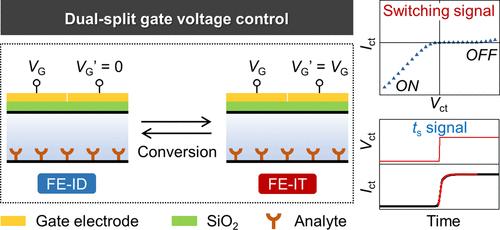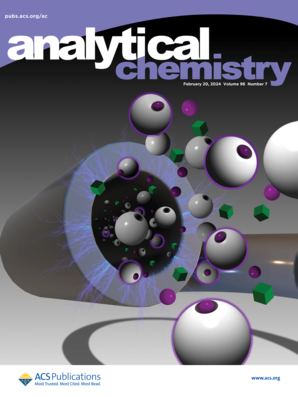Dual Ionic Signal Detection: Modulation of Surface Charge of Nanofluidic Iontronics by Dual-Split Gate Voltages
IF 6.7
1区 化学
Q1 CHEMISTRY, ANALYTICAL
引用次数: 0
Abstract
Nanofluidic iontronics, including the field-effect ionic diode (FE-ID) and field-effect ionic transistor (FE-IT), represent emerging nanofluidic logic devices that have been employed in sensitive analyses. Making analyte recognitions in predefined nanofluidic devices has been verified to improve the sensitivity and selectivity using a single ionic signal, such as ionic current amplification, rectification, and Coulomb blockade. However, the detection of analytes in complex systems generally necessitates more diverse signals beyond just ionic currents. Here, we demonstrated that dual ionic signals, steady ionic switching ratio, and transient response time (ts) act as detection signals modulated by dual-split gate voltages along the nanochannel for the detection of charged analytes. With an increase in gate voltage, the switching ratio decreases in both FE-ID and FE-IT, whereas the response time exhibits an exponential increase specifically in the FE-ID. Moreover, the response time shows no significant correlation with the external transmembrane voltage in the FE-IT. These results contribute to the optimization of reconfigurable iontronics through gate voltage modulation, providing a theoretical foundation for multiple ionic signal detection.

求助全文
约1分钟内获得全文
求助全文
来源期刊

Analytical Chemistry
化学-分析化学
CiteScore
12.10
自引率
12.20%
发文量
1949
审稿时长
1.4 months
期刊介绍:
Analytical Chemistry, a peer-reviewed research journal, focuses on disseminating new and original knowledge across all branches of analytical chemistry. Fundamental articles may explore general principles of chemical measurement science and need not directly address existing or potential analytical methodology. They can be entirely theoretical or report experimental results. Contributions may cover various phases of analytical operations, including sampling, bioanalysis, electrochemistry, mass spectrometry, microscale and nanoscale systems, environmental analysis, separations, spectroscopy, chemical reactions and selectivity, instrumentation, imaging, surface analysis, and data processing. Papers discussing known analytical methods should present a significant, original application of the method, a notable improvement, or results on an important analyte.
 求助内容:
求助内容: 应助结果提醒方式:
应助结果提醒方式:


